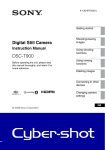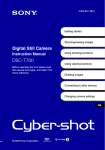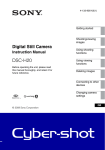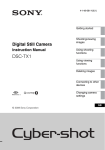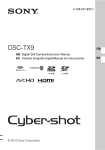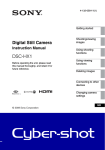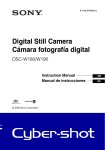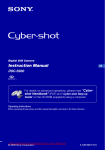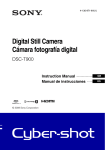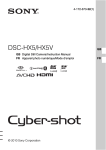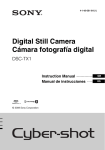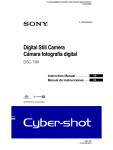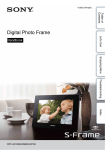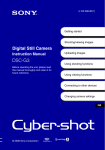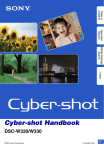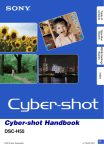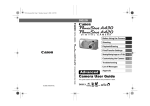Download Sony Cyber-shot DSC-T900 User Guide Manual pdf
Transcript
4-130-970-12(1) Getting started Digital Still Camera Instruction Manual DSC-T900 Before operating the unit, please read this manual thoroughly, and retain it for future reference. Shooting/viewing images Using shooting functions Using viewing functions Deleting images Connecting to other devices Changing camera settings GB © 2009 Sony Corporation Downloaded From camera-usermanual.com Sony Manuals Owner’s Record The model and serial numbers are located on the bottom. Record the serial number in the space provided below. Refer to these numbers whenever you call upon your Sony dealer regarding this product. Model No. DSC-T900 Serial No. ___________________________ WARNING To reduce fire or shock hazard, do not expose the unit to rain or moisture. IMPORTANT SAFEGUARDS For your protection, please read these safety instructions completely before operating the appliance, and keep this manual for future reference. Carefully observe all warnings, precautions and instructions on the appliance, or the one described in the operating instructions and adhere to them. Use For Customers in the U.S.A. [ Power Sources This set should be operated only from the type of power source indicated on the marking label. If you are not sure of the type of electrical power supplied to your home, consult your dealer or local power company. For those sets designed to operate from battery power, or other sources, refer to the operating instructions. [ Polarization This symbol is intended to alert the user to the presence of uninsulated “dangerous voltage” within the product’s enclosure that may be of sufficient magnitude to constitute a risk of electric shock to persons. This symbol is intended to alert the user to the presence of important operating and maintenance (servicing) instructions in the literature accompanying the appliance. This set may be equipped with a polarized ac power cord plug (a plug having one blade wider than the other). This plug will fit into the power outlet only one way. This is a safety feature. If you are unable to insert the plug fully into the outlet, try reversing the plug. If the plug should still fail to fit, contact your electrician to have a suitable outlet installed. Do not defeat the safety purpose of the polarized plug by forcing it in. [ Overloading Do not overload wall outlets, extension cords or convenience receptacles beyond their capacity, since this can result in fire or electric shock. [ Object and Liquid Entry Never push objects of any kind into the set through openings as they may touch dangerous voltage points or short out parts that could result in a fire or electric shock. Never spill liquid of any kind on the set. 2 Downloaded From camera-usermanual.com Sony Manuals GB [ Attachments [ Lightning Do not use attachments not recommended by the manufacturer, as they may cause hazards. For added protection for this set during a lightning storm, or when it is left unattended and unused for long periods of time, unplug it from the wall outlet and disconnect the antenna or cable system. This will prevent damage to the set due to lightning and power-line surges. [ Cleaning Unplug the set from the wall outlet before cleaning or polishing it. Do not use liquid cleaners or aerosol cleaners. Use a cloth lightly dampened with water for cleaning the exterior of the set. Installation [ Water and Moisture Do not use power-line operated sets near water – for example, near a bathtub, washbowl, kitchen sink, or laundry tub, in a wet basement, or near a swimming pool, etc. [ Power-Cord Protection Route the power cord so that it is not likely to be walked on or pinched by items placed upon or against them, paying particular attention to the plugs, receptacles, and the point where the cord exits from the appliance. [ Accessories Do not place the set on an unstable cart, stand, tripod, bracket, or table. The set may fall, causing serious injury to a child or an adult, and serious damage to the set. Use only a cart, stand, tripod, bracket, or table recommended by the manufacturer. [ Ventilation The slots and openings in the cabinet are provided for necessary ventilation. To ensure reliable operation of the set, and to protect it from overheating, these slots and openings must never be blocked or covered. – Never cover the slots and openings with a cloth or other materials. – Never block the slots and openings by placing the set on a bed, sofa, rug, or other similar surface. – Never place the set in a confined space, such as a bookcase, or built-in cabinet, unless proper ventilation is provided. – Do not place the set near or over a radiator or heat register, or where it is exposed to direct sunlight. Service [ Damage Requiring Service Unplug the set from the wall outlet and refer servicing to qualified service personnel under the following conditions: – When the power cord or plug is damaged or frayed. – If liquid has been spilled or objects have fallen into the set. – If the set has been exposed to rain or water. – If the set has been subject to excessive shock by being dropped, or the cabinet has been damaged. – If the set does not operate normally when following the operating instructions. Adjust only those controls that are specified in the operating instructions. Improper adjustment of other controls may result in damage and will often require extensive work by a qualified technician to restore the set to normal operation. – When the set exhibits a distinct change in performance – this indicates a need for service. [ Servicing Do not attempt to service the set yourself as opening or removing covers may expose you to dangerous voltage or other hazards. Refer all servicing to qualified service personnel. [ Replacement parts When replacement parts are required, be sure the service technician has used replacement parts specified by the manufacturer that have the same characteristics as the original parts. Unauthorized substitutions may result in fire, electric shock, or other hazards. [ Safety Check Upon completion of any service or repairs to the set, ask the service technician to perform routine safety checks (as specified by the manufacturer) to determine that the set is in safe operating condition. Downloaded From camera-usermanual.com Sony Manuals 3GB Read this first CAUTION For Customers in the U.S.A. and Canada [ Battery pack If the battery pack is mishandled, the battery pack can burst, cause a fire or even chemical burns. Observe the following cautions. • Do not disassemble. • Do not crush and do not expose the battery pack to any shock or force such as hammering, dropping or stepping on it. • Do not short circuit and do not allow metal objects to come into contact with the battery terminals. • Do not expose to high temperature above 60°C (140°F) such as in direct sunlight or in a car parked in the sun. • Do not incinerate or dispose of in fire. • Do not handle damaged or leaking lithium ion batteries. • Be sure to charge the battery pack using a genuine Sony battery charger or a device that can charge the battery pack. • Keep the battery pack out of the reach of small children. • Keep the battery pack dry. • Replace only with the same or equivalent type recommended by Sony. • Dispose of used battery packs promptly as described in the instructions. [ RECYCLING LITHIUM-ION BATTERIES Lithium-Ion batteries are recyclable. You can help preserve our environment by returning your used rechargeable batteries to the collection and recycling location nearest you. For more information regarding recycling of rechargeable batteries, call toll free 1-800-822-8837, or visit http://www.rbrc.org/ Caution: Do not handle damaged or leaking Lithium-Ion batteries. Battery charger This power unit is intended to be correctly orientated in a vertical or floor mount position. Replace the battery with the specified type only. Otherwise, fire or injury may result. Do not expose the batteries to excessive heat such as sunshine, fire or the like. 4 Downloaded From camera-usermanual.com Sony Manuals GB For Customers in the U.S.A. UL is an internationally recognized safety organization. The UL Mark on the product means it has been UL Listed. If you have any questions about this product, you may call: Sony Customer Information Center 1-800-222-SONY (7669) The number below is for the FCC related matters only. [ Regulatory Information Declaration of Conformity Trade Name: SONY Model No.: DSC-T900 Responsible Party: Sony Electronics Inc. Address:16530 Via Esprillo, San Diego, CA 92127U.S.A. Telephone No.: 858-942-2230 This device complies with Part 15 of the FCC Rules. Operation is subject to the following two conditions: (1) This device may not cause harmful interference, and (2) this device must accept any interference received, including interference that may cause undesired operation. [ Note: This equipment has been tested and found to comply with the limits for a Class B digital device, pursuant to Part 15 of the FCC Rules. These limits are designed to provide reasonable protection against harmful interference in a residential installation. This equipment generates, uses, and can radiate radio frequency energy and, if not installed and used in accordance with the instructions, may cause harmful interference to radio communications. However, there is no guarantee that interference will not occur in a particular installation. If this equipment does cause harmful interference to radio or television reception, which can be determined by turning the equipment off and on, the user is encouraged to try to correct the interference by one or more of the following measures: – Reorient or relocate the receiving antenna. – Increase the separation between the equipment and receiver. – Connect the equipment into an outlet on a circuit different from that to which the receiver is connected. – Consult the dealer or an experienced radio/TV technician for help. The supplied interface cable must be used with the equipment in order to comply with the limits for a digital device pursuant to Subpart B of Part 15 of FCC Rules. [ CAUTION You are cautioned that any changes or modifications not expressly approved in this manual could void your authority to operate this equipment. Downloaded From camera-usermanual.com Sony Manuals 5GB For Customers in Europe [ Notice for the customers in the countries applying EU Directives The manufacturer of this product is Sony Corporation, 1-7-1 Konan Minato-ku Tokyo, 1080075 Japan. The Authorized Representative for EMC and product safety is Sony Deutschland GmbH, Hedelfinger Strasse 61, 70327 Stuttgart, Germany. For any service or guarantee matters please refer to the addresses given in separate service or guarantee documents. This product has been tested and found compliant with the limits set out in the EMC Directive for using connection cables shorter than 3 meters (9.8 feet). [ Attention The electromagnetic fields at the specific frequencies may influence the picture and sound of this unit. [ Notice If static electricity or electromagnetism causes data transfer to discontinue midway (fail), restart the application or disconnect and connect the communication cable (USB, etc.) again. [ Disposal of Old Electrical & Electronic Equipment (Applicable in the European Union and other European countries with separate collection systems) This symbol on the product or on its packaging indicates that this product shall not be treated as household waste. Instead it shall be handed over to the applicable collection point for the recycling of electrical and electronic equipment. By ensuring this product is disposed of correctly, you will help prevent potential negative consequences for the environment and human health, which could otherwise be caused by inappropriate waste handling of this product. The recycling of materials will help to conserve natural resources. For more detailed information about recycling of this product, please contact your local Civic Office, your household waste disposal service or the shop where you purchased the product. 6 Downloaded From camera-usermanual.com Sony Manuals GB Disposal of waste batteries (applicable in the European Union and other European countries with separate collection systems) This symbol on the battery or on the packaging indicates that the battery provided with this product shall not be treated as household waste. By ensuring these batteries are disposed of correctly, you will help prevent potentially negative consequences for the environment and human health which could otherwise be caused by inappropriate waste handling of the battery. The recycling of the materials will help to conserve natural resources. In case of products that for safety, performance or data integrity reasons require a permanent connection with an incorporated battery, this battery should be replaced by qualified service staff only. To ensure that the battery will be treated properly, hand over the product at end-of-life to the applicable collection point for the recycling of electrical and electronic equipment. For all other batteries, please view the section on how to remove the battery from the product safely. Hand the battery over to the applicable collection point for the recycling of waste batteries. For more detailed information about recycling of this product or battery, please contact your local Civic Office, your household waste disposal service or the shop where you purchased the product. Notice for customers in the United Kingdom A moulded plug complying with BS 1363 is fitted to this equipment for your safety and convenience. Should the fuse in the plug supplied need to be replaced, a fuse of the same rating as the supplied one and approved by ASTA or BSI to BS 1362, (i.e., marked with an or mark) must be used. If the plug supplied with this equipment has a detachable fuse cover, be sure to attach the fuse cover after you change the fuse. Never use the plug without the fuse cover. If you should lose the fuse cover, please contact your nearest Sony service station. Downloaded From camera-usermanual.com Sony Manuals 7GB Table of contents IMPORTANT SAFEGUARDS ..................................................................... 2 Read this first ............................................................................................ 4 Notes on using the camera ..................................................................... 10 Getting started ................................................................... 12 Checking the accessories supplied ........................................................ 12 Identifying parts ....................................................................................... 13 Charging the battery pack....................................................................... 15 Inserting the battery pack/a “Memory Stick Duo” media (sold separately) ...................................................................................... 17 Setting the clock ...................................................................................... 19 Shooting/viewing images ...................................... 20 Shooting images ...................................................................................... 20 Viewing images........................................................................................ 21 Using shooting functions ........................................................ 22 Displaying minimum indicators (Easy Shooting) ..................................... 22 Detecting smiles and shooting automatically (Smile Shutter) ................. 23 Detecting the shooting conditions automatically (Scene Recognition) ... 24 Shooting close-ups (Macro/Close focus) ................................................ 26 Using the self-timer.................................................................................. 26 Selecting a flash mode ............................................................................ 27 Changing the screen display................................................................... 28 Focusing on a specific point of the frame ............................................... 29 Focusing on the face of the subject (Face Detection)............................. 29 Selecting the image size to match the usage.......................................... 30 Using the Shooting mode that matches the scene (Scene Selection) .... 32 Shooting movies ...................................................................................... 33 Using viewing functions .......................................................... 35 Viewing an enlarged image (Playback Zoom)......................................... 35 Displaying images full-screen (Wide Zoom)............................................ 35 Rotating a vertical orientation image (Temporarily rotated display)........ 36 Viewing still images with music (Slideshow)............................................ 36 Searching for an image (Image Index).................................................... 37 Selecting the display format (View Mode) ............................................... 37 8 Downloaded From camera-usermanual.com Sony Manuals GB Deleting images ............................................................................. 39 Deleting the currently displayed image .................................................. 39 Deleting multiple images......................................................................... 39 Deleting all images (Format) ................................................................... 40 Connecting to other devices ................................................. 41 Viewing images on a TV .......................................................................... 41 Printing still images ................................................................................. 42 Using the camera with a computer ......................................................... 44 Changing camera settings ...................................................... 48 Changing the operation sounds.............................................................. 48 Using the HOME screen.......................................................................... 48 Using the MENU items ............................................................................ 51 Using functions in Program Auto mode .................................................. 53 Others .................................................................................................. 54 List of icons displayed on the screen...................................................... 54 Learning more about the camera (“Cyber-shot Handbook”) .................. 56 Troubleshooting....................................................................................... 57 Precautions.............................................................................................. 60 Specifications .......................................................................................... 61 Downloaded From camera-usermanual.com Sony Manuals 9GB x Notes on using the camera Internal memory and “Memory Stick Duo” media back up Notes on the LCD screen Do not turn off the camera, remove the battery pack, or remove the “Memory Stick Duo” media while the access lamp is lit. Otherwise, the internal memory data or “Memory Stick Duo” media may be damaged. Be sure to make a backup copy to protect your data. extremely high-precision technology so over 99.99% of the pixels are operational for effective use. However, some tiny black and/ or bright dots (white, red, blue or green) may appear on the LCD screen. These dots are a normal result of the manufacturing process, and do not affect the recording. • If water droplets or other liquids splash on the LCD screen and make it wet, immediately wipe off the screen with a soft cloth. Leaving liquids on the LCD screen surface can harm the quality and cause a malfunction. On management files When you insert a “Memory Stick Duo” media without a management file into the camera and turn on the power, part of the “Memory Stick Duo” media capacity is used to automatically create a management file. It may take some time until you can perform the next operation. Notes on recording/playback • Before you start recording, make a trial • • • • • • • • recording to make sure that the camera is working correctly. The camera is neither dust-proof, nor splashproof, nor water-proof. Read “Precautions” (page 60) before operating the camera. Avoid exposing the camera to water. If water enters inside the camera, a malfunction may occur. In some cases, the camera cannot be repaired. Do not aim the camera at the sun or other bright light. It may cause the malfunction of the camera. Do not use the camera near a location that generates strong radio waves or emits radiation. Otherwise, the camera may not properly record or play back images. Using the camera in sandy or dusty locations may cause malfunctions. If moisture condensation occurs, remove it before using the camera (page 60). Do not shake or strike the camera. It may cause a malfunction and you may not be able to record images. Furthermore, the recording media may become unusable or image data may be damaged. Clean the flash surface before use. The heat of flash emission may cause dirt on the flash surface to become discolored or to stick to the flash surface, resulting in insufficient light emission. • The LCD screen is manufactured using Please use Sony genuine accessories If you use accessories manufactured by companies other than Sony, this could cause a camera trouble. • Using other manufacturers’ camera cases with magnets could cause a power supply trouble. On camera's temperature Your camera and battery may get warm due to continuous use, but it is not a malfunction. On the overheat protection Depending on the camera and battery temperature, you may be unable to record movies or the power may turn off automatically to protect the camera. A message will be displayed on the LCD screen before the power turns off or you can no longer record movies. On image data compatibility • The camera conforms with DCF (Design rule for Camera File system) universal standard established by JEITA (Japan Electronics and Information Technology Industries Association). • Sony does not guarantee that the camera will play back images recorded or edited with other equipment, or that other equipment will play back images recorded with the camera. GB 10 Downloaded From camera-usermanual.com Sony Manuals Warning on copyright Television programs, films, videotapes, and other materials may be copyrighted. Unauthorized recording of such materials may be contrary to the provisions of the copyright laws. No compensation for damaged content or recording failure Sony cannot compensate for failure to record or loss or damage of recorded content due to a malfunction of the camera or recording media, etc. Downloaded From camera-usermanual.com Sony Manuals 11GB Getting started Checking the accessories supplied • Battery charger BC-CSD (1) • CD-ROM (1) – Cyber-shot application software – “Cyber-shot Handbook” – “Cyber-shot Step-up Guide” • Instruction Manual (this manual) (1) x Using the wrist strap • Power cord (mains lead) (1) (not supplied in the USA and Canada) Getting started The camera is supplied with a wrist strap. Attach the strap and place your hand through the loop to prevent the camera from damage by being dropped. Hook • Rechargeable battery pack NP-BD1 (1)/ Battery case (1) x Using the paint pen • Paint pen (1) • USB Cable (1) The paint pen is used when operating the touch panel. It attaches to the wrist strap. Note • Do not carry the camera by holding the paint pen. The camera may fall off. • AV Cable (1) • Multi-output stand (1) • Wrist strap (1) GB 12 Downloaded From camera-usermanual.com Sony Manuals Identifying parts Camera A Shutter button B Speaker C Zoom (W/T) lever D Microphone I Lens cover J LCD screen/Touch panel K (Playback) button L Mode switch M Hook for wrist strap/Grip N Battery eject lever Getting started E ON/OFF (Power) button F Flash G Self-timer lamp/Smile Shutter lamp/ AF illuminator H Lens O Battery insertion slot P Tripod receptacle • Use a tripod with a screw less than 5.5 mm Bottom (7/32 inch) long. Otherwise, you cannot firmly secure the camera, and damage to the camera may occur. Q Multi connector R Battery/“Memory Stick Duo” media cover S Access lamp T “Memory Stick Duo” media slot Downloaded From camera-usermanual.com Sony Manuals 13GB Multi-output stand x Using AC Adaptor AC-LS5K (sold separately) v mark Getting started 1 To DC IN jack 2 To a wall outlet Use the multi-output stand for attaching the camera in the following cases. • Connecting a USB Cable to a computer • Connecting an AV Cable to a TV • PictBridge connection to a printer • Connecting the camera to AC Adaptor AC- LS5K (sold separately) will not charge the battery. Use a battery charger for charging the battery. A Camera connector terminal B DC IN jack C USB jack D HDMI jack E A/V OUT (STEREO) jack GB 14 Downloaded From camera-usermanual.com Sony Manuals Charging the battery pack the battery pack into 1 Insert the battery charger. • You can charge the battery even when it is partially charged. the battery 2 Connect charger to the wall For customers in the USA and Canada Plug outlet (wall socket). If you continue charging the battery pack for about one more hour after the CHARGE lamp turns off, the charge will last slightly longer (full charge). CHARGE lamp Lit: Charging Off: Charging finished (normal charge) Getting started Battery pack CHARGE lamp For customers in countries/regions other than the USA and Canada Power cord (mains lead) CHARGE lamp charging is finished, disconnect the battery 3 When charger. Downloaded From camera-usermanual.com Sony Manuals 15GB x Charging time Full charge time Normal charge time Approx. 220 min. Approx. 160 min. Notes • The table above shows the time required to charge a fully depleted battery pack at a temperature of 25°C (77°F). Charging may take longer depending on conditions of use and circumstances. • Connect the battery charger to the nearest wall outlet (wall socket). • Even if the CHARGE lamp is not lit, the battery charger is not disconnected from the AC power Getting started source (mains) as long as it is connected to the wall outlet (wall socket). If some trouble occurs while using the battery charger, immediately shut off the power by disconnecting the plug from the wall outlet (wall socket). • When charging is finished, disconnect the power cord (mains lead) from the wall outlet (wall socket), and remove the battery pack from the battery charger. • Designed for use with compatible Sony batteries and the battery charger. x Battery life and number of images you can record/view Battery life (min.) No. of Images Shooting still images Approx. 100 Approx. 200 Viewing still images Approx. 210 Approx. 4200 The measurement method is based on the CIPA standard. (CIPA: Camera & Imaging Products Association) Note • The battery life and the number of still images may vary depending on the camera settings. zUsing the camera abroad You can use the camera, the battery charger (supplied), and the AC-LS5K AC Adaptor (sold separately) in any country or region where the power supply is within 100 V to 240 V AC, 50/60 Hz. Do not use an electronic transformer (travel converter). This may cause a malfunction. GB 16 Downloaded From camera-usermanual.com Sony Manuals Inserting the battery pack/a “Memory Stick Duo” media (sold separately) 1 Open the cover. Getting started the “Memory Stick 2 Insert Duo” media (sold separately). With the terminal side facing the lens, insert the “Memory Stick Duo” media until it clicks into place. 3 Insert the battery pack. Check the direction of the battery, and insert it until the battery eject lever is locked. Battery eject lever 4 Close the cover. • Closing the cover with the battery inserted incorrectly may damage the camera. Downloaded From camera-usermanual.com Sony Manuals 17GB x “Memory Stick” media that you can use x When there is no “Memory Stick Duo” media inserted “Memory Stick Duo” media Images are stored in the camera’s internal memory (approximately 11 MB). To copy images from the internal memory to a “Memory Stick Duo” media, insert the “Memory Stick Duo” media in the camera, touch and select [Copy] in [Memory Tool] of (Manage Memory). Getting started You can also use a “Memory Stick PRO Duo” media or “Memory Stick PRO-HG Duo” media with the camera. For details on the number of images/time that can be recorded, see pages 31, 34. Other types of “Memory Stick” media or memory card are not compatible with the camera. x To remove the battery pack “Memory Stick” media You cannot use a “Memory Stick” media with the camera. Battery eject lever Slide the battery eject lever. Be sure not to drop the battery pack. x To remove the “Memory Stick Duo” media Access lamp Make sure that the access lamp is not lit, then push the “Memory Stick Duo” media in once. x Checking the remaining battery charge A remaining charge indicator appears on the upper left of the LCD screen. High Note • Never remove the “Memory Stick Duo” media/battery pack when the access lamp is lit. This may cause damage to data in the “Memory Stick Duo” media/internal memory. Low Notes • It takes about one minute until the correct remaining charge indicator appears. • The remaining charge indicator may not be correct under certain circumstances. • If the NP-FD1 battery pack (sold separately) is used, the minute display is also shown after the remaining charge indicator. • Battery capacity decreases over time and through repeated use. When the operating time per charge decreases markedly, the battery pack needs to be replaced. Purchase a new battery pack. • If the camera is running on and you do not operate the camera for about three minutes, the camera turns off automatically (Auto power-off function). GB 18 Downloaded From camera-usermanual.com Sony Manuals Setting the clock 1 Lower the lens cover. ON/OFF (Power) button The camera is turned on. • You can also turn on the camera by pressing the ON/OFF (Power) button. • It may take time for the power to turn on and allow operation. the desired date 2 Touch display format, then touch Getting started Lens cover . each item, then 3 Touch touch v/V to set its numeric value. • Midnight is indicated as 12:00 AM, and noon as 12:00 PM. 4 Touch [OK]. Note • The camera does not have a feature for superimposing dates on images. By using “PMB” in the CD-ROM (supplied), you can print or save images with the date. x Setting the date and time again Touch t (Settings) t [Clock Settings] (page 50). Downloaded From camera-usermanual.com Sony Manuals 19GB Shooting/viewing images Shooting images sure that the Mode 1 Make switch is set to (Still image) and lower the lens cover. • To shoot movies, set the Mode switch to (Movie) (page 33). Mode switch Shooting/viewing images Lens cover the camera steady 2 Hold as illustrated. • Zoom (W/T) lever Slide the zoom (W/T) lever to the T side to zoom. Slide to the W side to return. the shutter 3 Press button halfway down Shutter button SteadyShot mark to focus. is displayed to indicate that SteadyShot is working. When the image is in focus, a beep sounds and the z indicator lights. The shortest shooting distance is approximately 8 cm (3 1/4 inches) (W)/50 cm (19 3/4 inches) (T) (from the lens). the shutter 4 Press button fully down. The image is shot. GB 20 Downloaded From camera-usermanual.com Sony Manuals AE/AF lock Viewing images the 1 Press button. (Playback) The last image shot is displayed. • When images on the “Memory Stick Duo” media recorded with other cameras cannot be played back on this camera, view the images in [Folder View] (page 37). x Selecting next/previous image Touch screen. (Next)/ (Previous) on the x Deleting an image Touch Shooting/viewing images (Playback) button (Delete), then touch [OK]. x Returning to shooting images Press the shutter button halfway down. x Turning off the camera Close the lens cover. • You can also turn off the camera by pressing the ON/OFF (Power) button. Downloaded From camera-usermanual.com Sony Manuals 21GB Using shooting functions Displaying minimum indicators (Easy Shooting) This mode reduces the minimum number of settings and enlarges the text size for better visibility. 1 Set the Mode switch to (Still image). Mode) t 2 Touch(Easy(REC Shooting) t . Action How to change Self-Timer (Self-Timer) t Select (Self-Timer Off) or Image Size t Select [Large] or [Small] in [Image Size] Flash t Select [Auto] or [Off] in [Flash] x Returning to normal display Touch (REC Mode) t (Intelligent Auto Adjustment) t GB 22 Downloaded From camera-usermanual.com Sony Manuals . (Self-Timer 10sec) Detecting smiles and shooting automatically (Smile Shutter) 1 Set the Mode switch to 2 Touch (Smile). (Still image). point on the indicator, the camera shoots images automatically. When you touch (Smile) again, Smile Shutter ends. • If you press the shutter button during Smile Shutter, the camera shoots the image then returns to Smile Shutter mode. Face Detection frame Using shooting functions detecting a smile. 3 Wait When the smile level exceeds the b Smile Detection Sensitivity indicator zHints for better capturing of smiles 1 Do not cover the eyes with the bangs. 2 Try to orient the face in front of the camera and be as level as possible. The detection rate is higher when the eyes are narrowed. 3 Give a clear smile with an open mouth. The smile is easier to detect when the teeth are showing. Downloaded From camera-usermanual.com Sony Manuals 23GB Detecting the shooting conditions automatically (Scene Recognition) 1 Set the Mode switch to (Still image). (REC Mode) t 2 Touch (Intelligent Auto Adjustment) t or . the camera at the 3 Point subject. When the camera recognizes the scene, (Twilight), (Twilight Portrait), (Twilight using a tripod), (Backlight), (Backlight Portrait), (Landscape), (Macro) or (Portrait) appears. When the camera does not recognize the scene, appears on the screen of the camera. Scene Recognition icon the shutter button halfway down to focus and then 4 Press press the shutter button fully down to shoot the image. GB 24 Downloaded From camera-usermanual.com Sony Manuals z Selecting the image you prefer after taking two shots with different settings Touch t (Scene Recognition) t (Advanced). When the camera recognizes the scene (Twilight), (Twilight Portrait), (Twilight using a tripod), (Backlight), (Backlight Portrait) that poses difficulty of getting a clear shot, the camera automatically takes one more shot using a different effect by changing the settings as follows. Second Image Shoot in Slow Synchro Shoots with sensitivity increased and shake reduced Shoot in Slow Synchro with the face which the flash strobes on as guide Shoots with sensitivity increased with the face as guide and shake reduced Shoot in Slow Synchro Shoots with even slower shutter speed without increasing sensitivity Shoots with the flash Shoots with the brightness and contrast of the background adjusted (DROplus) Shoots with the face which the flash strobes on as guide Shoots with the brightness and contrast of the face and the background adjusted (DROplus) When set to [Advanced], the camera automatically shoots two images consecutively when it recognizes (Portrait). The camera will select, display, and record the image which the eyes are not blinked automatically. Downloaded From camera-usermanual.com Sony Manuals Using shooting functions First Image 25GB Shooting close-ups (Macro/Close focus) You can shoot beautiful close-up images of small subjects such as insects or flowers. (Macro) t 1 Touch desired mode t . (Auto): The camera adjusts the focus automatically from distant subjects to close-up. Normally, put the camera in this mode. (Macro On): The camera adjusts the focus with priority on close-up subjects. Set Macro On when shooting close subjects. (Close focus enabled): Use this mode to shoot at even closer distances than Macro recording. Locked to the W side: Approximately 1 to 20 cm (13/32 to 7 7/8 inches) Notes • You cannot select (Macro On) when the camera is in Intelligent Auto Adjustment mode. • Macro mode is fixed to (Auto) when the camera is in Movie Mode or Smile Shutter. Using the self-timer (Self-Timer) t 1 Touch desired mode t . (Self-Timer Off): Not using the self-timer. (Self-Timer 10sec): Shooting starts after a 10-second delay. Use this setting if you want to include yourself in the image. To cancel, touch . (Self-Timer 2sec): Shooting starts after a two-second delay. This is to prevent blurring due to unsteadiness when the shutter button is pressed. the shutter button. 2 Press The self-timer lamp flashes and a beep sounds until the shutter operates. GB 26 Downloaded From camera-usermanual.com Sony Manuals Selecting a flash mode (Flash) t 1 Touch desired mode t . (Flash Auto): Flashes when there is insufficient light or backlight (Flash On): Flash always operates. (Slow Synchro (Flash On)): Flash always operates. The shutter speed is slow in a dark place to clearly shoot the background that is out of flash light. (Flash Off): Flash does not operate. Notes (Flash On) or (Slow Synchro (Flash On)) are not available when the camera is in Intelligent Auto Adjustment mode. • You cannot use the flash during burst or bracket shooting. • Using shooting functions Downloaded From camera-usermanual.com Sony Manuals 27GB Changing the screen display 1 Touch mode t t desired . (Normal): Displays buttons and icons (Simple): Displays only buttons (Image Only): Hides buttons and icons Note • disappears from the screen if [Image Only] playback is selected. To display the buttons, touch the center of the screen. The [Normal] display returns temporarily. zHistogram and brightness settings The following setting can be accessed by touching . Histogram: A histogram is a graph showing the brightness of an image. The graph display indicates a bright image when skewed to the right side, and a dark image when skewed to the left side. Brightness: This sets the backlight brightness ([Normal]/[Bright]). When viewing images in bright outside light, reset to [Bright]. However, the battery power may decrease faster under such condition. GB 28 Downloaded From camera-usermanual.com Sony Manuals Focusing on a specific point of the frame Simply touch the point of the frame you wish to focus on to change the focus position. the camera at the 1 Point subject, then touch the point of the frame you want to focus on. You can change the focus point as many times as you wish before pressing the shutter button halfway down. • If you want the camera to choose a focus point automatically, touch . • : Face detected. : No face detected. The camera detects the face of the subject and focuses on it. You can select which subject takes priority when focusing. Using shooting functions Focusing on the face of the subject (Face Detection) Touch t (Face 1 Detection) t desired mode t . (When touched): Detects the face when an area with a face is touched on the screen. (Auto): Selects the face the camera is to automatically focus on. (Child Priority): Detects and shoots with priority on a child’s face. (Adult Priority): Detects and shoots with priority on an adult’s face. Downloaded From camera-usermanual.com Sony Manuals 29GB Selecting the image size to match the usage The image size determines the size of the image file that is recorded when you take a image. The larger the image size, the more detail will be reproduced when the image is printed on large-format paper. The smaller the image size, the more images can be recorded. Select the image size that matches the way you will view your images. t (Image Size) 1 t desired size t . Image size Usage guidelines (4000×3000) For prints up to A3+ size (3264×2448) For prints up to A3 size (2592×1944) For prints up to A4 size (2048×1536) For prints up to L/L2 size (640×480) For e-mail attachments (4000×2672) 3:2 aspect ratio as in photo prints and postcards (4000×2248) For viewing on a high-definition TV. LCD screen Images are displayed in 4:3 or 3:2 aspect ratio. (1920×1080) Images will fill the entire screen. Note • When you print images shot with 16:9 aspect ratio, both edges may be cut off. GB 30 Downloaded From camera-usermanual.com Sony Manuals x Number of still images that can be recorded (Units: Images) Capacity Internal memory Size “Memory Stick Duo” media formatted with this camera Approx. 256 MB 512 MB 11 MB 1 GB 2 GB 4 GB 8 GB 16 GB 12M 2 40 84 173 351 693 1401 8M 2 56 118 242 493 972 1963 3991 5M 3 68 143 293 595 1174 2372 4821 3M 2847 7 144 301 617 1253 2472 4991 10140 70 1383 2897 5924 12030 23730 47910 97390 3:2(11M) 2 43 91 187 380 751 1516 3082 16:9(9M) 2 44 94 192 390 770 1555 3162 16:9(2M) 11 230 482 987 2005 3955 7986 16230 VGA Notes media. • When the number of remaining shootable images is greater than 9,999, the “>9999” indicator appears. • When an image shot with other cameras is played back on this camera, the image may not appear in the actual image size. Downloaded From camera-usermanual.com Sony Manuals Using shooting functions • The number of still images may vary depending on the shooting conditions and the recording 31GB Using the Shooting mode that matches the scene (Scene Selection) 1 Set the Mode switch to (Still image). select / / / / / : 2 To Touch (REC Mode) t desired mode t . To select / / / / : Touch (REC Mode) t (Scene Selection) t desired mode t . (High Sensitivity): Shoots images without a flash even in low lighting. (Gourmet): Shoots food arrangements in delicious color. (Beach): Shoots seaside or lakeside scenes with the blueness of the water captured more vividly. (Soft Snap): Shoots images with a softer atmosphere for portraits of people, flowers, etc. (Snow): Shoots snow scenes in white more clearly. (Landscape): Shoots with the focus on a distant subject. (Fireworks): Shoots fireworks in all their splendor. (Twilight Portrait): Shoots sharp images of people in a dark place without losing the nighttime atmosphere. (Underwater): Shoots underwater in natural colors in housing (such as Marine Pack). (Twilight): Shoots night scenes without losing the nighttime atmosphere. (Hi-Speed Shutter): Shoots moving subjects in bright places. Note • The flash does not operate in some modes. GB 32 Downloaded From camera-usermanual.com Sony Manuals Shooting movies sure that the Mode 1 Make switch is set to (Movie) and lower the lens cover. Mode switch Lens cover x Viewing movies Press the (Playback) button and touch the a movie to view. Button (Next) / (Previous) buttons to select Action Using shooting functions 2 Press the shutter button fully down to start recording. 3 Press the shutter button fully down again to stop recording. Volume control B Playback x Stop M/m Fast forward/fast rewind x Image size The larger the image size, the higher the image quality. The higher the amount of data used per second (average bit rate), the smoother the playback image. Movie image size Average bit rate Usage guidelines 1280×720(Fine) 9 Mbps Shoot highest quality movies for display on High Definition TV. 1280×720(Standard) 6 Mbps Shoot standard quality movies for display on High Definition TV. VGA 3 Mbps Shoot an image size suitable for WEB upload. Downloaded From camera-usermanual.com Sony Manuals 33GB x Maximum recording time The table below shows the approximate maximum recording times. These are the total times for all movie files. Continuous shooting is possible for approximately 29 minutes. (Units: hour: minute: second) Capacity Internal memory Size Approx. 11 MB “Memory Stick Duo” media formatted with this camera 256 MB 512 MB 1 GB 2 GB 4 GB 8 GB 16 GB 1280×720 (Fine) – 0:03:00 0:06:30 0:13:30 0:27:40 0:54:40 1:50:40 3:45:10 1280×720 (Standard) – 0:04:30 0:09:50 0:20:20 0:41:30 1:22:10 2:46:10 5:38:00 0:08:40 0:18:20 0:37:40 1:16:50 2:31:50 5:06:50 10:24:00 VGA 0:00:10 Notes • The recording time may vary depending on the shooting conditions and the recording media. • The continuous shooting time differs according to the shooting circumstances (temperature, etc.). The numbers in the table above are when [Brightness] of the (screen display) is set to [Normal]. • Movies with the size set to [1280×720] can only be recorded on a “Memory Stick PRO Duo” media. GB 34 Downloaded From camera-usermanual.com Sony Manuals Using viewing functions Viewing an enlarged image (Playback Zoom) the (Playback) 1 Press button to display an image, then touch the area you want to enlarge. The image is enlarged at twice the size, with the area you touched at the center. When is set to [Image Only], touch the center of the screen, then touch the area you want to enlarge. the zoom scale and 2 Adjust position. Shows the displayed area of the whole image Displaying images full-screen (Wide Zoom) Using viewing functions The zoom scale increases each time you touch the screen. / / / : Adjusts the position. : Changes the zoom scale. : Turns / / / on/off. : Cancels playback zoom. the (Playback) 1 Press button to display the still image, then touch • Touch zoom. . again to end the wide Downloaded From camera-usermanual.com Sony Manuals 35GB Rotating a vertical orientation image (Temporarily rotated display) the (Playback) 1 Press button to display the still image, then select the vertical orientation images, then touch . • Touch again to end the display. Viewing still images with music (Slideshow) the (Playback) 1 Press button to display a still image, then touch (Slideshow). [Start]. 2 Touch The slideshow starts. • To end the slideshow, touch the screen, and then touch [Exit]. zSelecting background music You can transfer a desired music file from your CDs or MP3 files to the camera to play back during slideshow. To transfer music files, install the “Music Transfer” software (supplied) to your computer (page 45), then follow the steps below. 1 Touch t (Slideshow) t [Music Tool] t [Download Music]. 2 Make a USB connection between the camera and your computer. 3 Start and operate “Music Transfer”. For details on “Music Transfer”, see the “Music Transfer” help. GB 36 Downloaded From camera-usermanual.com Sony Manuals Searching for an image (Image Index) the (Playback) 1 Press button to display an image, then touch Index). • If you touch , you can set the number of images displayed in the index screen to 12 or 20 images. 2 Touch pages. • (Image / to turn the To return to the single-image screen, touch the thumbnail image. Allows you to select the display format for viewing multiple images when using “Memory Stick Duo” media. Using viewing functions Selecting the display format (View Mode) the (Playback) 1 Press button to display an image, then touch (Image Index) t (View Mode) t desired mode. (Date View): Displays images by the date. (Event View): Analyzes the dates shots and frequency, automatically organizes the images into groups and displays them. (Favorites): Displays images registered as Favorites. (Folder View): Displays and organizes images by folders. Downloaded From camera-usermanual.com Sony Manuals 37GB x Easily locating the images to be displayed When set to Date View/Event View/Folder View: When using a “Memory Stick Duo” media, touch (Date List), (Select Folder) to easily locate the desired images. (Event List) or Date List: Displays a list of the images taken on the selected date. Event List: Displays a list of the images registered to the selected event. Select Folder: Touch [OK] to display a list of the images contained in the selected folder. When set to Favorites: You can display images registered to Favorites divided into six groups. Favorites: Displays a list of the images registered to the selected Favorites number. Note • When you cannot play back images recorded with other cameras, view the images in [Folder View]. GB 38 Downloaded From camera-usermanual.com Sony Manuals Deleting images Deleting the currently displayed image 1 Touch (Delete) t [OK] (page 21). Deleting multiple images (Image Index) t 1 Touch (Delete). images for deletion. 2 Select 1 Touch / to turn the pages, then Deleting images touch the images you want to delete. The mark is attached to the selected images. 2 Repeat step 1. t [OK]. 3 Touch You can switch between single-image and index screen using / , when selecting images. x Deleting in date, event or folder units t (Delete) t Folder) t t [OK]. (All in Date Range), (All in Event) or (All in This • The images is displayed in [Folder View] when using the internal memory. Downloaded From camera-usermanual.com Sony Manuals 39GB Deleting all images (Format) You can delete all data stored on “Memory Stick Duo” media or the internal memory. If a “Memory Stick Duo” media is inserted, all data stored on the “Memory Stick Duo” media are deleted. If no “Memory Stick Duo” media is inserted, all data stored in the internal memory are deleted. 1 Touch t (Manage Memory) t [Memory Tool] t t [Format] t . 2 Touch [OK]. Note • Formatting permanently deletes all data, including protected images. GB 40 Downloaded From camera-usermanual.com Sony Manuals Connecting to other devices Viewing images on a TV 1 2 Attach the camera to the multi-output stand (supplied). Connect the multi-output stand to the TV with the AV Cable (supplied). To the A/V OUT (STEREO) jack To audio/video input jacks AV Cable (supplied) Note • The [Video Out] setting is set to [NTSC] mode at the factory to let you enjoy optimum movie image quality. When images do not appear or jitter on your TV, you may be using a PAL-only TV. Try switching the [Video Out] setting to [PAL] (page 50). You can view images recorded on the camera by connecting the camera to an HD (High Definition) TV with the HDMI Cable (sold separately) or HD Output Adaptor Cable (sold separately). When using the HDMI Cable: • Select t (Settings) t [Main Settings 2] to select [Auto] or [1080i] for [HDMI Resolution]. • Use an HDMI Cable with the HDMI logo. Connecting to other devices zViewing images on a HD (High Definition) TV When using the HD Output Adaptor Cable: t (Settings) t [Main Settings 2] to select [HD(1080i)] for [COMPONENT]. • Use a Type2c-compliant HD Output Adaptor Cable. • Select Downloaded From camera-usermanual.com Sony Manuals 41GB Printing still images If you have a PictBridge compliant printer, you can print images by the following procedure. 1 2 Attach the camera to the multi-output stand (supplied). 3 Turn on the printer, and press the 4 Touch t (Print) t desired item t . Connect the multi-output stand to the printer with the USB Cable (supplied). After the connection is made, the (Playback) button. indicator appears. (This Image): Print the currently displayed image. (Multiple Images): Touch / to display the image, then touch the image you want to print. 5 Touch the desired setting item, then [OK]. The image is printed. Note • If the connection between the camera and the printer is not established, disconnect the USB Cable, touch t [PictBridge] t (Settings) t [Main Settings] t t [USB Connect] t and start over the procedure from step 2. t zPrinting at a shop You cannot print images stored in the internal memory at a print shop directly from the camera. Copy the images to a “Memory Stick Duo” media, then take the “Memory Stick Duo” media to the print shop. t [Copy] How to copy: Touch t (Manage Memory) t [Memory Tool] t t t [OK]. For details, consult your photo printing service shop. GB 42 Downloaded From camera-usermanual.com Sony Manuals zSuperimposing dates on images This camera does not include a function for superimposing a date on an image. The reason for this is to prevent the date from being duplicated during printing. Printing at a shop: You can ask that images be printed with a date superimposed. For details, consult with a photo printing service shop. Printing at home: Connect to a PictBridge-compliant printer, and press [Print] t [Date] to [Date] or [Day&Time]. (Playback) button, then set t Superimposing dates on images using PMB: With the supplied “PMB” software installed on a PC (page 45), you can directly superimpose the date on an image. However, note that when images with a superimposed date are printed, the date may be duplicated depending on print settings. For details on “PMB”, see the “PMB Guide” (page 47). Connecting to other devices Downloaded From camera-usermanual.com Sony Manuals 43GB Using the camera with a computer x Using “PMB (Picture Motion Browser)” You can enjoy the recorded images more than ever by taking advantage of the software, and “PMB” is included on a CD-ROM (supplied). There are more functions, in addition to those listed below, for enjoying your images. For details, see the “PMB Guide” (page 47). Import to computer Calendar Media service Uploading the image to the media service. Viewing images in a calendar. Print CD/DVD Printing images with date stamps. Creating a data disc using a CD burner drive or DVD burner drive. Export to camera Exporting images to a “Memory Stick Duo” media and viewing them. Note • “PMB” is not compatible with Macintosh computers. GB 44 Downloaded From camera-usermanual.com Sony Manuals x Stage 1: Installing the “PMB” (supplied) You can install the software (supplied) using the following procedure. When you install “PMB,” “Music Transfer” is also installed. • Log on as Administrator. 1 Check your computer environment. Recommended environment for using “PMB” and “Music Transfer” OS (pre-installed): Microsoft Windows XP*1 SP3/Windows Vista*2 SP1 CPU: Intel Pentium III 800 MHz or faster (For playing/editing the High Definition movies: Intel Pentium 4 2.8 GHz or faster/Intel Pentium D 2.8 GHz or faster/ Intel Core Duo 1.66 GHz or faster/Intel Core 2 Duo 1.20 GHz or faster) Memory: 512 MB or more (For playing/editing the High Definition movies: 1 GB or more) Hard Disk (Disk space required for installation): approximately 500 MB Display: Screen resolution: 1,024 × 768 dots or more Video memory: 32 MB or more (Recommended: 64 MB or more) *1 64-bit editions and Starter (Edition) are not supported. *2 Starter (Edition) is not supported. 2 Turn on your computer, and insert the CD-ROM (supplied) into the CD-ROM drive. The installation menu screen appears. Click [Install]. 4 Follow the instructions on the screen to complete the installation. 5 Remove the CD-ROM after the installation is complete. The “Choose Setup Language” screen appears. Downloaded From camera-usermanual.com Sony Manuals Connecting to other devices 3 45GB x Stage 2: Importing images to your computer using “PMB” 1 Insert a fully charged battery pack to the camera and then attach the camera to the multi-output stand (supplied). 2 3 Press the (Playback) button. Connect the camera to your computer. “Connecting…” appears on the screen of the camera. 1 To a USB jack 2 To a USB jack USB Cable • 4 is displayed on the screen during the communication session. Do not operate the computer while the indicator is displayed. When the indicator changes to , you can start using the computer again. Click the [Import] button. For details, see the “PMB Guide”. GB 46 Downloaded From camera-usermanual.com Sony Manuals x Stage 3: Viewing “PMB Guide” 1 Double-click the (PMB Guide) icon on the desktop. • To access the “PMB Guide” from the start menu: Click [Start] t [All Programs] t [Sony Picture Utility] t [Help] t [PMB Guide]. Notes • Do not disconnect the USB Cable from the camera while the camera is operating or while “Accessing…” appears on the screen of the camera. Doing so may corrupt the data. • When using a battery with little remaining charge, you may not be able to transfer the data or the data may be corrupted. Using the AC Adaptor (sold separately) and the multi-output stand (supplied) is recommended. x Using the camera with your Macintosh computer You can copy images to your Macintosh computer. However, “PMB” is not compatible. When images are exported to the “Memory Stick Duo” media, view them in [Folder View]. You can install “Music Transfer” on your Macintosh computer. Recommended computer environment The following environment is recommended for a computer connected to the camera. Recommended environment for using “Music Transfer” OS (pre-installed): Mac OS X (v10.3 to v10.5) Memory: 64 MB or more (128 MB or more is recommended) Hard Disk (Disk space required for installation): approximately 50 MB Downloaded From camera-usermanual.com Sony Manuals Connecting to other devices Recommended environment for importing images OS (pre-installed): Mac OS 9.1/9.2/ Mac OS X (v10.1 to v10.5) USB jack: Provided as standard 47GB Changing camera settings Changing the operation sounds You can set the sound produced when you operate the camera. Touch t (Settings) 1t [Main Settings] t t [Beep] t mode t . t desired Shutter: Turns on the shutter sound when you press the shutter button. High/Low: Turns on the beep/shutter sound when you operate the touch panel/press the shutter button. If you want to lower the volume, select [Low]. Off: Turns off the beep/shutter sound. Using the HOME screen On the HOME screen, camera operations are organized for convenience into broad categories for selection, such as shooting, viewing and printing images. Only the items that are available for each mode are displayed on the screen. x Shooting Item Description Shooting Records still images or movies. GB 48 Downloaded From camera-usermanual.com Sony Manuals x View Images Item Description Date View* Displays images by the date. Event View* Analyzes the dates shots and frequency, automatically organizes the images into groups and displays them. Favorites* Displays images registered as Favorites. Folder View Displays and organizes images by folders. * These items are displayed only when “Memory Stick Duo” media is inserted into the camera. x Slideshow Item Description Slideshow Plays back images in succession along with effects and music. Music Tool Download Music: Format Music: x Print Item Description Print Prints still images. x Changes the slideshow music. Deletes all slideshow music. Manage Memory Item Description Memory Tool - “Memory Stick” Tool Format: Create REC.Folder: Change REC.Folder: Delete REC.Folder: Copy: Memory Tool - Internal Memory Tool Format: File Number: Formats the internal memory. Selects the method used to assign file number to images. Downloaded From camera-usermanual.com Sony Manuals Changing camera settings File Number: Formats a “Memory Stick Duo” media. Creates a new folder on a “Memory Stick Duo” media. Changes the folder used for recording images. Deletes a folder in a “Memory Stick Duo” media. Copies all images recorded in the internal memory to a “Memory Stick Duo” media. Selects the method used to assign file number to images. 49GB x Settings Item Description Main Settings - Main Settings 1 Beep: Function Guide: Initialize: Calibration: Housing: Demo Mode: Main Settings - Main Settings 2 HDMI Resolution: CTRL FOR HDMI: COMPONENT: Video Out: TV TYPE: USB Connect: Shooting Settings Shooting Settings 1 AF Illuminator: Grid Line: Digital Zoom: Shooting Settings Shooting Settings 2 Auto Orientation: Auto Review: Selects the beeps produced when you operate the camera. Displays the function guide. Restores the camera to its default settings. Corrects misalignment of the response positions of the buttons on the touch panel. Changes the button operations when the camera is in the housing (Marine Pack). Demonstrates the Smile Shutter and Scene Recognition function. Sets the resolution to be output to a TV when the camera is connected to a High Definition TV. Enables you to operate the camera using the TV remote controller when your camera is connected to a “BRAVIA” Sync compatible TV. Sets the video signal according to a connected TV terminal. Sets the mode according to the video output system to be connected. Set to the aspect ratio of a TV to be connected. Sets the mode used when connecting the camera to a computer or a printer. Strobes the fill light when focusing in low light. Displays lines to easily set a subject in a horizontal or vertical position. Selects the zoom method for zoom in excess of optical zoom. Recognizes the orientation change and saves the image in the proper orientation. Displays the image on the screen for approximately two seconds after shooting a still image. Clock Settings Sets the date and time. Language Setting Selects the language to be used in the menu items, warnings and messages. GB 50 Downloaded From camera-usermanual.com Sony Manuals Using the MENU items Displays available functions for easy setting when the camera is in shooting or playback mode. Only the available items are displayed on the screen. t (Settings) t To restore the camera to its default settings, touch [Main Settings 1] t [Initialize]. x MENU in shooting mode Item Description Image Size Sets the image size. ( / / / / ( 1280×720(Fine)/ / / / ) 1280×720(Standard)/ VGA) REC Mode Selects the continuous shooting method. EV Adjusts exposure manually. ISO Sets the ISO sensitivity. (ISO AUTO/ISO80 to ISO3200) White Balance Adjusts color tones according to the surrounding light conditions. ( Normal/ Burst/BRK±0.3EV/BRK±0.7EV/BRK±1.0EV) (–2.0EV to +2.0EV) ( Cloudy/ Fluorescent Light 1, Fluorescent Light 3/n Incandescent/ Underwater White Balance Adjusts the colors when shooting underwater. Focus Changes the focus method. Metering Mode Sets which part of the subject to measure to determine the exposure. Scene Recognition Automatically detects the shooting conditions and then takes the shot. ( ( ( ( Smile Detection Sensitivity Auto/ Multi AF/ Multi/ Auto/ Underwater 1, Underwater 2) ) Center) Changing camera settings Auto/ Daylight/ Fluorescent Light 2, Flash) Advanced) Sets the level of sensitivity to detect smile. ( Big Smile/ Normal Smile/ Downloaded From camera-usermanual.com Sony Manuals Slight Smile) 51GB Item Description Face Detection Selects the priority subject for adjusting the focus when using face detection. Flash Level Adjusts the amount of flash light. Anti Blink Sets Anti Blink function. Red Eye Reduction Sets to reduce the red-eye phenomenon. ( ( ( ( When touched/ / Auto/ Standard/ Auto/ Auto/ Child Priority/ Adult Priority) ) Off) On/ Off) DRO Optimizes the brightness and contrast. Color Mode Changes the vividness of the image or adds special effects. SteadyShot Selects the anti-blur mode. Shooting Settings Selects the shooting settings. ( ( ( Off/ DRO standard/ Normal/ Vivid/ Shooting/ DRO plus) Sepia/ Continuous/ B & W) Off) x MENU in viewing mode Item Description (Date List) Selects the playback date list. (Event List) Selects the event group to be played back. (Select Folder) Selects the folder for viewing images. (View Mode) Switches the View Modes. ( (Filter by Faces) Date View/ Event View/ Favorites/ Folder View) Plays back images filtered to meet certain conditions. ( Off/ Smiles) All people/ Children/ Infants/ (Slideshow) Plays back images in succession along with effects and music. (Add / Remove Favorites) Adds images to Favorites or removes images from Favorites. (Retouch) ( This Image/ Multiple Images/ Add All in Date Range*/ Remove All in Date Range*) * The displayed text differs according to each View Mode. Retouches still images. ( (Paint) (Multi-Purpose Resize) Trimming/ Soft Focus/ Radial Blur/ Red Eye Correction/ Unsharp masking/ Partial Color/ Fisheye Lens/ Cross Filter/ Retro/ Happy Faces) Paints on a still image and saves as a new image. Changes the image size according to usage. ( HDTV/ Blog/E-mail) GB 52 Downloaded From camera-usermanual.com Sony Manuals Item Description (Delete) Deletes images. ( This Image/ Multiple Images/ All in Date Range*) * The displayed text differs according to each View Mode. (Protect) Prevents accidental erasure. ( This Image/ Multiple Images/ Set All in Date Range*/ Remove All in Date Range*) * The displayed text differs according to each View Mode. Adds a Print order mark to the image you want to print in a “Memory Stick Duo” media. ( This Image/ Multiple Images/ Set All in Date Range*/ Remove All in Date Range*) * The displayed text differs according to each View Mode. (Print) Prints images using a PictBridge compliant printer. ( This Image/ Multiple Images/ All in Date Range*) * The displayed text differs according to each View Mode. (Rotate) Rotates a still image. (Volume Settings) Adjusts the volume. Using functions in Program Auto mode You can change the Focus, Metering Mode, ISO, and EV settings when [REC Mode] is set to (Program Auto). Description (Focus) Changes the focus method. ( Multi AF/ Center AF/ ) (Metering Mode) Measures the metering area. ( Multi/ Center/ (ISO) Sets the ISO sensitivity. (ISO AUTO/ISO80 to ISO3200) (EV) Adjusts the exposure. (–2.0EV to +2.0EV) Spot) Downloaded From camera-usermanual.com Sony Manuals Spot AF/0.5m/1.0m/3.0m/7.0m/ Changing camera settings Item 53GB Others List of icons displayed on the screen Icons are displayed on the screen to indicate the camera status. You can select the display settings by touching the indication on the bottom right of the screen (page 28). When shooting still images A Display Indication Battery remaining Low battery warning Scene Recognition Scene Recognition icon Smile Detection Sensitivity indicator • The icons are limited in (Easy Shooting) mode. When shooting movies Zoom scaling View Mode Filter by Faces PMB export Favorites Protect Print order (DPOF) mark Playback zoom When playing back B Display Indication Image size SteadyShot Recording folder 96 GB 54 Downloaded From camera-usermanual.com Sony Manuals Number of recordable images Display Indication Display Indication 8/8 Image number/Number of images recorded in selected folder C:32:00 Self-diagnosis display 100 Min Histogram • appears when Recordable time Recording/Playback Media (“Memory Stick Duo” media, internal memory) histogram display is disabled. D PictBridge connecting Display Indication PictBridge connecting 35° 37' 32" N 139° 44' 31" E Latitude and Longitude display z AE/AF lock Changing folder Playback folder NR slow shutter DRO White balance 125 Shutter speed F3.5 Aperture value ISO400 ISO number +2.0EV Exposure Value Recording mode Metering mode Face Detection Flash Metering Mode White balance Focus Vibration warning Macro/Close focus Touch AF indicator Flash mode Color mode REC Standby Recording a movie/Standby a movie Flash level 0:12 Recording time (m:s) Flash charging N Playback Red-eye reduction Playback bar C Display Indication AF range finder frame 0:00:12 Counter 101-0012 Folder-file number 2009 1 1 9:30 AM Recorded date/time of the playback image Others Spot metering cross hair Self-timer AF illuminator Housing Management file full Temperature increase warning VOL. Volume Downloaded From camera-usermanual.com Sony Manuals 55GB Learning more about the camera (“Cybershot Handbook”) “Cyber-shot Handbook”, which explains how to use the camera in detail, is included on the CD-ROM (supplied). Refer to it for in-depth instructions on the many functions of the camera. • You need Adobe Reader to read “Cyber-shot Handbook”. If it is not installed on your computer, you can download it from web page: http://www.adobe.com/ x For Windows users 1 Turn on your computer, and insert the CD-ROM (supplied) into the CD-ROM drive. 2 Click “Cyber-shot Handbook”. 3 Start “Cyber-shot Handbook” from the shortcut on the desktop. “Cyber-shot Step-up Guide”, which contains information on accessories for the camera, is installed at the same time. x For Macintosh users 1 Turn on your computer, and insert the CD-ROM (supplied) into the CD-ROM drive. 2 Select the [Handbook] folder and copy “Handbook.pdf” stored in the [GB] folder to your computer. 3 After copying is complete, double-click “Handbook.pdf”. GB 56 Downloaded From camera-usermanual.com Sony Manuals Troubleshooting If you experience trouble with the camera, try the following solutions. 1 Check the items below, and refer to “Cyber-shot Handbook” (PDF). If a code such as “C/E:ss:ss” appears on the screen, refer to “Cyber-shot Handbook.” 2 Remove the battery pack, wait for about one minute, re-insert the battery pack, then turn on the power. 3 Initialize the settings (page 50). 4 Consult your Sony dealer or local authorized Sony service facility. On repairing cameras with internal memory or Music files function included, data in the camera may be checked on minimum necessity to verify and improve the malfunction symptoms. Sony will not copy or save any of those data. Battery pack and power Cannot insert the battery pack. • Make sure the direction of the battery is correct, and insert it until the battery eject lever is locked (page 17). Cannot turn on the camera. • After inserting the battery pack into the camera, it may take a few moments for the camera to power up. • Insert the battery pack correctly (page 17). • The battery pack is discharged. Insert a charged battery pack (page 15). • The battery pack is dead. Replace it with a new one. • Use a recommended battery pack. • Depending on the camera and battery temperature, the power may turn off automatically to Others The power turns off suddenly. protect the camera. In this case, a message is displayed on the LCD screen before the power turns off. • If you do not operate the camera for about three minutes while the power is on, the camera turns off automatically to prevent wearing down the battery pack. Turn on the camera again (page 18). • The battery pack is dead. Replace it with a new one. Downloaded From camera-usermanual.com Sony Manuals 57GB The remaining charge indicator is incorrect. • The battery charge will get used up quickly and the actual remaining battery charge will be lower than the indicator in the following cases: – When you use the camera in an extremely hot or cold location. – When you use the flash and zoom frequently. – When you repeatedly turn the power on and off. – When [Brightness] of the (screen display) is set to [Bright]. • A discrepancy arose between the remaining charge indicator and the actual remaining battery charge. Fully discharge the battery pack once, then charge it to correct the indication. • The battery pack is discharged. Insert the charged battery pack (page 15). • The battery pack is dead. Replace it with a new one. Cannot charge the battery pack while inside the camera. • You cannot charge the battery pack using the AC Adaptor (sold separately). Use the battery charger (supplied) to charge the battery. The CHARGE lamp flashes while charging the battery. • Remove and reinsert the battery pack, making sure it is installed correctly. • The temperature may be inappropriate for charging. Try charging the battery pack again within the proper charging temperature range (10°C to 30°C (50°F to 86°F)). Shooting still images/movies Cannot record images. • Check the free capacity of the internal memory or “Memory Stick Duo” media (pages 31, 34). If it is full, do one of the following: – Delete unnecessary images (page 39). – Change the “Memory Stick Duo” media. • You cannot record images while charging the flash. • Set the Mode switch to the correct mode. • Movies with the size set to [1280×720] can only be recorded on a “Memory Stick PRO Duo” media. When using recording media other than “Memory Stick PRO Duo” media, set the movie image size to [VGA]. • The camera is in Smile Shutter demonstration mode. Set [Demo Mode] to [Off]. White, black, red, purple or other vertical streaks appear, or the whole screen of the image becomes reddish when you are shooting a very bright subject. • This is called “smear phenomenon”. This is not a malfunction. GB 58 Downloaded From camera-usermanual.com Sony Manuals Viewing images Cannot play back images. • Press (Playback) button (page 21). • The folder/file name has been changed on your computer. • No guarantees are made for playing back, on this camera, files containing images which were processed on a computer or images which were shot using other cameras. • The camera is in USB mode. Delete the USB connection. • You may not be able to play back some images stored on the “Memory Stick Duo” media shot using other cameras. Play such images in Folder View (page 37). • This is caused by copying images on your computer to the “Memory Stick Duo” media without using the “PMB”. Play such images in Folder View (page 37). Others Downloaded From camera-usermanual.com Sony Manuals 59GB Precautions Do not use/store the camera in the following places • In an extremely hot, cold or humid place • • • • In places such as in a car parked in the sun, the camera body may become deformed and this may cause a malfunction. Under direct sunlight or near a heater The camera body may become discolored or deformed, and this may cause a malfunction. In a location subject to rocking vibration Near strong magnetic place In sandy or dusty places Be careful not to let sand or dust get into the camera. This may cause the camera to malfunction, and in some cases this malfunction cannot be repaired. On carrying Do not sit down in a chair or other place with the camera in the back pocket of your trousers or skirt, as this may cause malfunction or damage the camera. On cleaning Cleaning the LCD screen Wipe the screen surface with an LCD cleaning kit (sold separately) to remove fingerprints, dust, etc. Cleaning the lens Wipe the lens with a soft cloth to remove fingerprints, dust, etc. Cleaning the camera surface Clean the camera surface with a soft cloth slightly moistened with water, then wipe the surface with a dry cloth. To prevent damage to the finish or casing: – Do not expose the camera to chemical products such as thinner, benzine, alcohol, disposable cloths, insect repellent, sunscreen or insecticide. – Do not touch the camera with any of the above on your hand. – Do not leave the camera in contact with rubber or vinyl for a long time. On operating temperatures Your camera is designed for use under the temperatures between 0°C and 40°C (32°F and 104°F). Shooting in extremely cold or hot places that exceed this range is not recommended. On moisture condensation If the camera is brought directly from a cold to a warm location, moisture may condense inside or outside the camera. This moisture condensation may cause a malfunction of the camera. If moisture condensation occurs Turn off the camera and wait about an hour for the moisture to evaporate. Note that if you attempt to shoot with moisture remaining inside the lens, you will be unable to record clear images. On the internal rechargeable backup battery This camera has an internal rechargeable battery for maintaining the date and time and other settings regardless of whether the power is on or off. This rechargeable battery is continually charged as long as you are using the camera. However, if you use the camera for only short periods, it discharges gradually, and if you do not use the camera at all for about one month it becomes completely discharged. In this case, be sure to charge this rechargeable battery before using the camera. However, even if this rechargeable battery is not charged, you can still use the camera, but the date and time will not be indicated. Charging method of the internal rechargeable backup battery Insert charged battery pack in the camera, and then leave the camera for 24 hours or more with the power off. GB 60 Downloaded From camera-usermanual.com Sony Manuals Specifications Camera [Power, general] [System] Power: Rechargeable battery pack NP-BD1, 3.6 V NP-FD1 (sold separately), 3.6 V AC-LS5K AC Adaptor (sold separately), 4.2 V Power consumption (during shooting): 1.2 W Operating temperature: 0 to 40°C (32 to 104°F) Storage temperature: –20 to +60°C (–4 to +140°F) Dimensions: 97.9 × 57.8 × 16.3 mm (3 7/8 × 2 3/8 × 21/32 inches) (W/H/D, excluding protrusions) Mass (including NP-BD1 battery pack and a “Memory Stick Duo” media): Approx. 147 g (5.2 oz) Microphone: Stereo Speaker: Monaural Exif Print: Compatible PRINT Image Matching III: Compatible PictBridge: Compatible Image device: 7.79 mm (1/2.3 type) color CCD, Primary color filter Total pixel number of camera: Approx. 12.4 Megapixels Effective pixel number of camera: Approx. 12.1 Megapixels Lens: Carl Zeiss Vario-Tessar 4× zoom lens f = 6.18 – 24.7 mm (35 – 140 mm (35 mm film equivalent)) F3.5 (W) – F4.6 (T) When shooting movies (16:9): 38 – 152 mm When shooting movies (4:3): 46 – 184 mm Exposure control: Automatic exposure, Scene Selection (11 modes) White balance: Automatic, Daylight, Cloudy, Fluorescent 1,2,3, Incandescent, Flash Underwater White Balance: Auto, Underwater 1,2 Recording interval for Burst mode: approx. 0.57 seconds Recording system: Still images: JPEG (DCF Ver. 2.0, Exif Ver. 2.21, MPF Baseline) compliant, DPOF compatible Movies: MPEG-4 Visual Recording media: Internal Memory (approx. 11 MB), “Memory Stick Duo” media Flash: Flash range (ISO sensitivity (Recommended exposure Index) set to Auto): Approx. 0.08 to 4.5 m (3 1/4 inches to 14 feet 9 1/4 inches) (W)/ approx. 0.5 to 3.2 m (1 feet 7 3/4 inches to 10 feet 6 inches) (T) [Input and Output connectors] Power requirements: AC 100 V to 240 V, 50/60 Hz, 2.2 W Output voltage: DC 4.2 V, 0.33 A Operating temperature: 0 to 40°C (32 to 104°F) Storage temperature: –20 to +60°C (–4 to +140°F) Dimensions: Approx. 62 × 24 × 91 mm (2 1/2 × 31/32 × 3 5/8 inches) (W/H/D) Mass: Approx. 75 g (2.7 oz) Multi-output stand [Input jacks] A/V OUT (STEREO) jack (Stereo): Mini jack (USB) jack: Mini-B jack USB communications: Hi-Speed USB (USB 2.0 Hi-Speed compatible) HDMI jack DC IN jack Camera connector Others Multi connector: Multi connector Type2c (AV-out(SD/HD Component)/HDMI/USB/DC-in) Video output Audio output (STEREO) USB communication USB communication: Hi-Speed USB (USB 2.0 compliant) BC-CSD battery charger [LCD screen] LCD panel: Wide (16:9), 8.8 cm (3.5 type) TFT drive Total number of dots: 921 600 (1920 × 480) dots Downloaded From camera-usermanual.com Sony Manuals 61GB Rechargeable battery pack NP-BD1 Trademarks • The following marks are trademarks of Sony Corporation. Used battery: Lithium-ion battery Maximum voltage: DC 4.2 V Nominal voltage: DC 3.6 V Maximum charge current: 1.24 A Maximum charge voltage: DC 4.2 V Capacity: typical: 2.4 Wh (680 mAh) minimum: 2.3 Wh (620 mAh) Design and specifications are subject to change without notice. , “Cyber-shot,” “Memory , “Memory Stick PRO,” , “Memory Stick Duo,” , “Memory Stick PRO Duo,” , “Memory Stick PRO-HG Duo,” , “Memory Stick Micro,” “MagicGate,” , “BRAVIA,” “PhotoTV HD,” “Info LITHIUM” HDMI, HDMI logo and High Definition Multimedia Interface are trademarks or registered trademarks of HDMI Licensing LLC. Microsoft, Windows, DirectX and Windows Vista are either registered trademarks or trademarks of Microsoft Corporation in the United States and/or other countries. Macintosh and Mac OS are trademarks or registered trademarks of Apple Inc. Intel, MMX, and Pentium are trademarks or registered trademarks of Intel Corporation. Adobe and Reader are either trademarks or registered trademarks of Adobe Systems Incorporated in the United States and/or other countries. In addition, system and product names used in this manual are, in general, trademarks or registered trademarks of their respective developers or manufacturers. However, the ™ or ® marks are not used in all cases in this manual. Stick,” • • • • • • GB 62 Downloaded From camera-usermanual.com Sony Manuals Downloaded From camera-usermanual.com Sony Manuals Additional information on this product and answers to frequently asked questions can be found at our Customer Support Website. Printed on 70% or more recycled paper using VOC (Volatile Organic Compound)-free vegetable oil based ink. Printed inFrom Japan Downloaded camera-usermanual.com Sony Manuals
































































